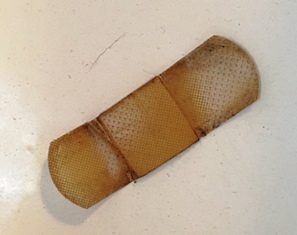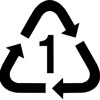Your plastic band-aid will, anyway, which is a little funny considering its momentary use on that annoying hang-nail, yet the hundreds of years it will be around after you. This is not an endorsement to stop using

band-aids, but maybe we should think before we offer it to our child who really doesn’t need it to begin with (I’m guilty of that, just to stop the whining). This is all part of my obsession with plastic which started last month when I decided that I would stop using it, in any form. I’ve never liked the fact that it doesn’t break down and that it will be hanging around long after the human race has ended.
Videos with sea turtles having juice box straws permanently stuck up their noses, birds with soda straws stuck in their throats, or animals dying from plastic bag asphyxiation disturb me. I have seen my kids take two sips of a juice box they really didn’t want and throw the rest away. They didn’t throw it in the ocean, but that doesn’t matter – it’s still just a momentary throw-away item that will be around forever. A few years ago, I went back to my childhood home on the coast of Maine. My brothers and I loved to play on the rocky beach, jumping from huge rock to huge rock, and exploring the many tide pools. I was dismayed during my visit to find the coastline littered with tiny pieces of plastic, broken down as far as it would go, and speckled throughout the many rocks; it was everywhere. We didn’t see that years ago. The plastic wasn’t there, but it is now, and it’s multiplying.
So I decided it was time to put an end to my plastic dependency, then at least I knew that I wasn’t contributing to the problem. I just wouldn’t buy it any more, simple. Then I started to look around and all I saw was plastic in my life. Take a moment and look around your home, especially the kitchen and bathroom, and you will see how pervasive it is, particularly with packaging. Bathroom: shampoo – plastic bottle, deodorant – plastic holder, toothpaste – plastic container, toothbrush – plastic handle and bristles, razor – plastic handle, blades are encased in plastic. In the kitchen: milk – plastic jug, butter – plastic container, bread – plastic bag, lunch meat and cheese – plastic container or bags, chips – plastic bag, granola bars – individually wrapped in plastic (just because the liner is silver, doesn’t mean it’s recyclable foil ). And it doesn’t stop, everywhere you look – plastic!
I didn’t know what to do about this problem. I didn’t think I could stop using plastic immediately, it’s too difficult to end it outright in one day. Well, if I wanted to be unshaven, un-deodorized, and un-brushed, but I don’t think many of you would want to hang out with me (and I wouldn’t want to be around myself either – too fragrant). My son also didn’t like the idea of us living off of pickles and olives because that was all I could find in our fridge in glass jars.
So, what to do?
Recycle, obviously, save the plastic from its fate of landfills and oceans where animals consume it and pay the price. It’s estimated that Americans recycle only one plastic water bottle out of four; the rest end up in the garbage. Recycling has been a part of my life since it was possible to do it, even bringing aluminum to the local store in Maine to get $.05 a can and then buying candy with the earnings (which was more of a self-serving endeavor). I also knew that not every item could be recycled, but like many people, I just ignorantly threw it in the recycle bin, ever hopeful. I decided that I would start my ceasing of plastic by finding out what is recyclable and trying to buy those products, while trying not to buy anything encased in plastic that can’t be recycled and doesn’t break down. Here’s what I learned:
Most plastic items or packaging have a number on them enclosed in a little triangle with arrows. My best friend thought that th e little triangle with arrows meant that it was recyclable because that is the recycle sign to her, but that’s not the case. That symbol is there to tell you what kind of plastic it is, not to signify that it can be recycled. Without getting too crazy about the many types of plastic and its uses, here is what usually can be recycled and what can’t.
e little triangle with arrows meant that it was recyclable because that is the recycle sign to her, but that’s not the case. That symbol is there to tell you what kind of plastic it is, not to signify that it can be recycled. Without getting too crazy about the many types of plastic and its uses, here is what usually can be recycled and what can’t.
YES – Recyclable
#1 (PET plastic) – usually water or soda bottles – often have a redemption value on them.
#2 (HDPE plastic) – milk jugs, detergent bottles, plastic bags.
SOMETIMES Recyclable (depends on the recycling facility)
#4 (LDPE plastic) – squeezable bottles, bags for packaged bread, dry cleaner garment bags.
#5 (PP plastic) – bags in cereal boxes, butter and yogurt containers, packing tape.
NOT Recyclable
#3 (PVC) – clear plastic food wrapping, irrigation pipes, kids toys (and this type of plastic is toxic too)
#6 (PS) – Styrofoam cups and food containers (take-out), straws, coffee or beverage lids, egg cartons, plastic cutlery, packing “peanuts.” This is the plastic that usually ends up on beaches and accounts for 35% of landfill waste.
#7 (Other) – this is the catch-all for a variety of different plastics and which often contains the dreaded BPA, which is a known endocrine disrupter. Water cooler bottles, car parts, baby bottles, sippy cups are often made of #7. Most items claim they are “BPA free,” but removing the BPA means adding some other chemical that has not been tested. Just don’t buy #7 if possible, if anything, for health reasons.
I will keep you posted on my attempt to live plastic-free, but right now it’s seems nearly impossible and just downright depressing.
If you’re interested, here are a few things you can do:
1) Don’t get a straw when you go out to eat. Just sip your drink instead. I know that is harder to do with kids and the spill factor. Stay tuned for solutions to this one.
2) Bring your own coffee cup to Starbucks, Peet’s, etc. That one is hard for me to remember, like re-usable shopping bags once were, but it’s just a new habit to form. I tried to go without a lid and ended up with my latte all over me when I stopped short at a red light. No fun.
3) At your next party or get-together, use regular old metal cutlery. It is very easy to put it in the dishwasher instead of using throw-away plastic. Or, if you already bought plastic forks, re-use them. Most boxes are labeled “dishwasher safe.”
4) And the usual, recycle when possible before our grandchildren or their grandchildren are buried in plastic and can’t fight back when the aliens land (kidding, I’m not that crazy, yet).
However, if anyone finds me incoherent and mumbling, “the plastic, the plastic!” you all know why . Just drop me off in a forest somewhere, hopefully one that doesn’t have the dreaded plastic plants.